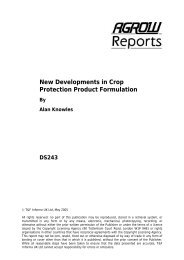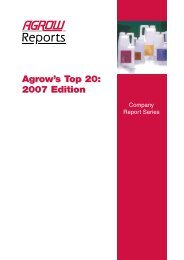BASF ups new ais and pipeline sales potential - Agrow
BASF ups new ais and pipeline sales potential - Agrow
BASF ups new ais and pipeline sales potential - Agrow
- TAGS
- basf
- pipeline
- agrow
- www.agrow.com
Create successful ePaper yourself
Turn your PDF publications into a flip-book with our unique Google optimized e-Paper software.
AGROW | No 633 | February 8th 2012 Americas<br />
South American region seeks<br />
flexible agchem approvals<br />
The South American customs union the Andean Community’s<br />
(CAN) pesticides committee, the Cotasa de Plaguicidas, wants<br />
to “rationalise <strong>and</strong> make flexible” the harmonised agricultural<br />
use pesticide agrochemical registration process. CAN member<br />
state representatives from Bolivia, Colombia, Ecuador <strong>and</strong> Peru<br />
met late last year at the 120th Cotasa reunion, <strong>and</strong> produced<br />
three joint initiatives.<br />
They agreed to adopt amendments to Resolution 630<br />
covering the data required from an applicant for a product<br />
registration, <strong>and</strong> what modifications a registrant can request<br />
to a registration. Resolution 630 of 2002, along with Decision<br />
436 of 1998, set the harmonised pesticide registration regime<br />
in the union (<strong>Agrow</strong> No 422, p 21).<br />
The amendments would establish requirements for the<br />
following policies: the processing of <strong>new</strong> authorisations of<br />
an approved pesticide under a different name; defining the<br />
conditions for adding manufacturers, formulators <strong>and</strong> the<br />
countries of origin for an approved pesticide; <strong>and</strong> regulating<br />
the requirements for r<strong>ais</strong>ing the application rate of an approved<br />
pesticide <strong>and</strong> re-setting its toxicological category.<br />
The first of those is designed to allow the agrochemical<br />
industry to develop strategies for supplying the same product<br />
with different names in separate niche markets <strong>and</strong> different<br />
trading conditions, while the second would aim to facilitate<br />
<strong>and</strong> exp<strong>and</strong> product supplies in domestic markets, while<br />
responding to moves in international markets, the Cotasa<br />
explains.<br />
The meeting also considered the flexibility in the requirements<br />
for the registration of active ingredients that are under patent<br />
or data protection.<br />
The Cotasa called on the secretary general of the CAN to<br />
process the amendments of the Resolution <strong>and</strong> Decision as<br />
soon as possible to improve member states’ competitiveness.<br />
It further called for member states to evaluate the possibility<br />
of establishing harmonised procedures <strong>and</strong> requirements<br />
for the registration <strong>and</strong> control of plant growth regulators<br />
<strong>and</strong> adjuvants, including their import, export, manufacture,<br />
formulation, packaging <strong>and</strong> distribution.<br />
The meeting supported three proposals, which it decided “to<br />
move on in the short to medium term”. The first concerns<br />
a project for setting maximum residue limits (MRLs) on<br />
four “low toxicity” pesticides. The Cotasa hopes to gain the<br />
support of the WTO <strong>and</strong> the USDA on the project, which covers<br />
Syngenta’s fungicide, azoxystrobin, <strong>and</strong> three insecticides:<br />
DuPont’s chlorantraniliprole, Dow AgroSciences’ spinetoram<br />
<strong>and</strong> Sumitomo Chemical’s pyriproxyfen.<br />
It would not only grant access to significant international<br />
resources but also lead to the inclusion of Codex Alimentarius<br />
MRLs that can subsequently be extrapolated to more than 20<br />
tropical plants of the region, facilitating exports particularly to<br />
the EU, the Conasa notes.<br />
The second supported proposal was to take part in the second<br />
global minor-use summit (GMUS-II), which takes place this<br />
month <strong>and</strong> to which Colombia was invited as a member of the<br />
advisory committee. The summit is of particular significance<br />
to CAN member states in facilitating internationally recognised<br />
approvals of products for use on minor crops. The last adopted<br />
proposal was for the creation of a network of laboratories across<br />
the region for the control of pesticide formulations <strong>and</strong> residues.<br />
Earlier in 2011, the secretary general of the CAN launched a<br />
project in association with the FAO to improve the control of<br />
pesticide use in the region. The secretary general accepted that<br />
highly toxic pesticides continued to be used in the region. The<br />
project was scheduled to last two years, <strong>and</strong> would include the<br />
establishment of the regional laboratory network among other<br />
capacity r<strong>ais</strong>ing goals of a technically improved registration<br />
system <strong>and</strong> post-registration controls.<br />
INTELLIGENCE<br />
South/Central Am agchem <strong>sales</strong><br />
up 30% in 2011<br />
The agrochemical market for South <strong>and</strong> Central America rose<br />
by 29.7% in 2011 to $10,875 million, industry association<br />
CropLife Latin America reports. The association cites preliminary<br />
figures from market research company Phillips McDougal <strong>and</strong><br />
includes the <strong>sales</strong> from all of its national affiliate markets except<br />
Mexico. After currency effects <strong>and</strong> inflation are removed, the<br />
adjusted growth was of some 15.3%.<br />
Brazil accounted for over 70% of <strong>sales</strong> at just over $7,800<br />
million, below mooted expectations in the country of breaching<br />
the Dow’s $8,000 million <strong>new</strong> mark. sulfoximine The next largest compound<br />
market, Argentina,<br />
saw estimated <strong>sales</strong> of $1,271 million. That would be heavily<br />
Recent published patents from Dow AgroSciences divulge activity<br />
down around on the a certain estimated N-sulfoximine 2010 national compound market, with insecticidal which was<br />
reported properties. to have The compound, risen by 28% according in 2010 to the to claims over $1,600 from US million<br />
(<strong>Agrow</strong> patent No No 615, 20100152245A1 p 24). entitled “Insecticidal N-substituted<br />
(6-haloalkylpyridin-3-yl)-alkyl sulfoximines” of June 2010, describes<br />
The the figures general show structure three of other the active South ingredient American <strong>and</strong> nations the preferences saw <strong>sales</strong><br />
regarding its radicals.<br />
above $100 million in 2011, namely Colombia with $374<br />
million, The preferred Chile at structure $200 million, is: <strong>and</strong> Ecuador ($168 million).<br />
The next largest markets were closely bunched with Venezuela<br />
at $81 million, followed by Bolivia ($75 million) <strong>and</strong> Peru ($72<br />
million), while the combined <strong>sales</strong> in the Central American<br />
states such as Guatemala <strong>and</strong> Costa Rica amounted to $440<br />
million.<br />
The overall rise for the area was the largest regional increase<br />
in the world, the report notes. Strong economies, favourable<br />
weather conditions, the strengthening of the Brazilian currency,<br />
<strong>and</strong> The the compound incidence is said of the to be soybean active against disease, pests frog that eye have leaf become spot<br />
(Cercospora<br />
resistant to<br />
sojina),<br />
one or more<br />
as well<br />
insecticides<br />
as rising<br />
currently<br />
dem<strong>and</strong><br />
on<br />
for<br />
the<br />
cotton<br />
market,<br />
<strong>and</strong><br />
as it<br />
either has a <strong>new</strong> mode of action or an atypical one. Pests targeted<br />
sugar include cane aphids, supported plant hoppers, growth. leafhoppers, <strong>and</strong> whiteflies when<br />
used on food <strong>and</strong> non-food crops.<br />
For more details, log in to <strong>Agrow</strong> INTELLIGENCE<br />
Intelligence <strong>and</strong> read through<br />
profile No. P0232.<br />
For enquiries, please email the <strong>Agrow</strong> Intelligence editor,<br />
Leila Nabih, at leila.nabih@informa.com.<br />
©Informa UK Ltd 2012 www.agrow.com 15





